Phase Out Of Ozone-Depleting Substances
Table of Contents
- 1 Phase Out Of Ozone-Depleting Substances
- 2 HCFC-22 (R-22) Allocation Rule
- 3 A Summary Of How This Will Affect You
- 4 Phasing Out R-22 Means Expensive A/C Repairs
- 5 Servicing Existing Units
- 6 Ozone-friendly Alternatives
- 7 Deciding What To Do
- 8 R-22 FAQs
- 8.0.1 What Refrigerants Do Air Conditioners Use?
- 8.0.2 What Are HCFC Refrigerants?
- 8.0.3 Is R-22 Already Illegal?
- 8.0.4 How Much Does A Pound Of R-22 Cost?
- 8.0.5 What Is R-22 Refrigerant?
- 8.0.6 Which Gas Is Used In Air Conditioners?
- 8.0.7 Can The Condensing Unit (The Outside Unit) On A Home Air Conditioner Containing HCFC-22 Be Replaced?
- 8.0.8 Do I Need To Stop Using HCFC-22 In My Home’s Air Conditioner?
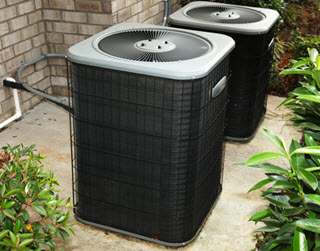 Ozone depleting substances, commonly referred to as “ODS,” are regulated within the United States as either Class I or Class II controlled substances. Substances such as chlorofluorocarbons are classified under the Clean Air Act as Class I ODS materials. These gases are used in many common materials, such as packaging, solvents, insulation, and aerosol propellants. In addition they are used for refrigeration and air conditioning.
Ozone depleting substances, commonly referred to as “ODS,” are regulated within the United States as either Class I or Class II controlled substances. Substances such as chlorofluorocarbons are classified under the Clean Air Act as Class I ODS materials. These gases are used in many common materials, such as packaging, solvents, insulation, and aerosol propellants. In addition they are used for refrigeration and air conditioning.
The Earth’s lower atmosphere does not destroy these gases and, as such, they rise to the upper atmosphere. Under certain conditions, CFCs can then break down ozone. The breaking down of the ozone layer is a bad thing for the Earth and its environment. This has caused problems in the past, and if things do not change, these problems will simply get worse.
Learn More About R-22 Phaseout Facts
Replacements For CFS
In order to help solve this problem, there are other compounds that are being used as interim replacements for CFS. These compounds include hydrochlorofluorocarbons and hydrofluorocarbons. Compounds like these are covered under the Montreal and Kyoto Protocols, respectively. These substances are commonly referred to as “greenhouse gases.”
Class I And Class II Ozone Depleting Substances
Substances that fall into the Class I have a higher potential for depleting ozone. As such, these materials have been phased out within the United States already. These materials are not allowed to be produced or imported into the United States. There are a few exceptions only. That being said, there is now a need for other coolants that can be used in place of the ozone-damaging coolants.
Class II materials are currently being utilized as transitional substitutes for the Class I materials that can no longer be used. This hydrochlorofluorocarbon (HCFC) materials will also be phased out eventually. It is part of the overall phase out plan. In the case of most HCFCs, import and new production were phased out by January of 2020. One of these materials within this class is commonly used in refrigeration equipment and air conditioners. This material is HCFC-22, which is commonly referred to as R-22.
HCFCs are most commonly used as refrigerants. HCFC-22, and chemicals within the same class, were ultimately phased out in order to protect the Earth’s ozone layer. Under the Clean Air Act, the import and production of substances that deplete ozone are being phased out gradually. In the United States, this means that the amount of ozone-depleting substances that are imported or produced are illegal. This phase-out schedule has been changed over time. Parties to the Montreal Protocol have made adjustments through various amendments. In the United States, this phase-out has been accelerated by the EPA with the passing of the Clean Air Act.
What Is Expected With Phasing Out These Substances?
Phasing out substances that deplete ozone is expected to decrease the risk of skin cancer. Exposure to UV radiation will decrease. Climate change is also expected to be slowed. Substances that deplete ozone and the greenhouse gases that are being substituted during the phase-out contribute to climate change. As such, the phase-out the R-22 coolant is a good way to help protect the environment, the climate, and the health of everyone.
HCFC-22 (R-22) Allocation Rule
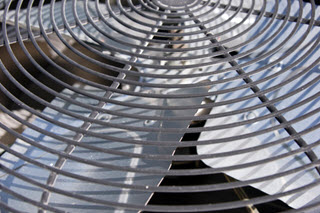 As the HCFC-22 refrigerant has officially been phased out within the United States, it will be necessary for consumers to stay informed. This is especially true when it concerns which coolant is used in their AC units. The age of their units plays a significant role. When purchasing a new air conditioner or when repairing or servicing an existing unit, staying informed about coolant is important. Newly manufactured equipment is now banned from containing R-22. So, it is no longer possible to purchase an air conditioner from the manufacturer that already contains the R-22 coolant. When purchasing a new air conditioner unit, you will need to take a few key factors into account.
As the HCFC-22 refrigerant has officially been phased out within the United States, it will be necessary for consumers to stay informed. This is especially true when it concerns which coolant is used in their AC units. The age of their units plays a significant role. When purchasing a new air conditioner or when repairing or servicing an existing unit, staying informed about coolant is important. Newly manufactured equipment is now banned from containing R-22. So, it is no longer possible to purchase an air conditioner from the manufacturer that already contains the R-22 coolant. When purchasing a new air conditioner unit, you will need to take a few key factors into account.
Usually cost, performance, reliability, and energy efficiency are the main considerations. However, you will also need to consider the refrigerant being used. The lengthiness of the phase-out period allows for the replacement of a unit that contains R-22, once it becomes too old to be effective or efficient. Since the final phase of the refrigerant has been reached, supplies of R-22 are dwindling. Additionally, the price of the R-22 coolant is rising, because of the dwindling supply. Although R-22 currently remains available to service equipment manufactured prior to 2010, higher prices and scarcer supplies are occuring.
Does Your Air Conditioner Need More Refrigerant?
Schedule Of The Phase-Out
In the United States, the phase-out has been progressing on schedule. Certain portions of the ban have already taken place. On January 1, 2010, the production, import and usage of HCFC-22 and HCFC-142b were banned except to service existing equipment. On January 1, 2015 this ban included the production, import, and usage of all HCFCs, except to service existing equipment. As of January 1, 2020, the final phase of the ban makes it illegal for the import or production of HCFC-22 and HCFC-142b. After the year 2020, any servicing of systems that use R-22 will need to be performed with stockpiled or recycled quantities of this coolant.
A/C Units That Use Ozone Depleting Substances
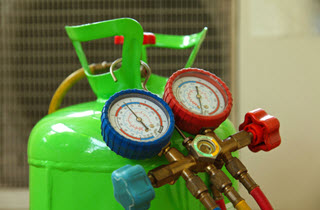 Fortunately, it is not necessary to immediately stop using or replace all units that utilize R-22. You will have time to replace air conditioning units according to a normal schedule, thanks to the phase-out period. Since air conditioner units are commonly expected to last approximately ten to fifteen years, you have time to switch over to more ozone-friendly coolant units. However, it is realistic to expect prices for servicing R-22 systems to rise. This is due to the ever-dwindling supply of this coolant. The higher cost of maintenance is a factor that needs to be considered when planning to use and maintain an older unit for a few more years.
Fortunately, it is not necessary to immediately stop using or replace all units that utilize R-22. You will have time to replace air conditioning units according to a normal schedule, thanks to the phase-out period. Since air conditioner units are commonly expected to last approximately ten to fifteen years, you have time to switch over to more ozone-friendly coolant units. However, it is realistic to expect prices for servicing R-22 systems to rise. This is due to the ever-dwindling supply of this coolant. The higher cost of maintenance is a factor that needs to be considered when planning to use and maintain an older unit for a few more years.
Servicing Systems With R-22
It is important to maintain your air conditioner unit properly. By doing so, it will be less likely to need servicing. This is a good way to avoid the higher servicing costs that will become more common as R-22 supplies continue to dwindle. In addition to reducing maintenance costs, proper servicing also helps to minimize any potential environmental damage. It is prudent to instruct service technicians to locate and fix any leaks in the equipment, instead of simply “topping off” the coolant. This will help lower the cost of servicing, conserve R-22 coolant, and help to protect the ozone layer. It is also important to note that technicians must use equipment designed to recover the refrigerant during service. It is illegal to release coolants intentionally into the atmosphere when making repairs. Also, in order to service equipment that contains R-22, service technicians must be EPA Section 608 certified.
What Does The Phase-Out Mean For You?
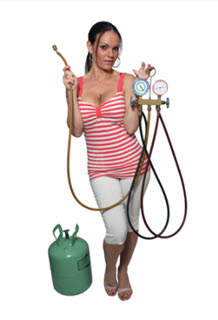 Refrigerant is, of course, an incredibly important part of an air conditioning unit. If your air conditioner was installed prior to 2010, it is important to find out what type of coolant it uses. This will allow you to plan accordingly. If you have had your air conditioner longer than ten years, it is likely that it contains the R-22 coolant. Before 2010, R-22 was the predominant refrigerant for air conditioners since its introduction in the 1950s.
Refrigerant is, of course, an incredibly important part of an air conditioning unit. If your air conditioner was installed prior to 2010, it is important to find out what type of coolant it uses. This will allow you to plan accordingly. If you have had your air conditioner longer than ten years, it is likely that it contains the R-22 coolant. Before 2010, R-22 was the predominant refrigerant for air conditioners since its introduction in the 1950s.
Unfortunately, although it has been commonly used for years, it has been discovered that the R-22 coolant, and other compounds like it, have been accelerating the depletion of the Earth’s ozone layer. As such, ongoing efforts by the EPA and other groups have been working on a phase-out plan. Production and import of R-22 began to be prohibited in 2010, except for the case of existing equipment. As such, R-22 was still available for purchase and use until January 2015. By 2020, new R-22 will no longer be available.
A Summary Of How This Will Affect You
Within North America, R-22 is no longer being manufactured. It is still available as a recycled product. This is for the purpose of servicing existing units. The cost for this coolant continues to rise. This is due to the limited supply of this material which continues to decrease. By 2020, it may not be easily available for use at all in the United States.
If your air conditioner was manufactured after January 2010, the rules and regulations concerning air conditioners and coolants most likely do not apply to you.
Options
A New Air Conditioning System
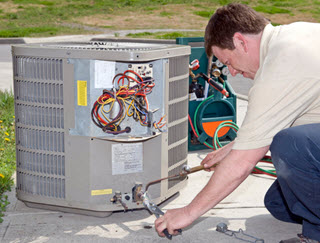 If you have an air conditioner that was manufactured prior to January 2010, you have some options. You could purchase a unit that uses a more environmentally friendly, approved coolant. You could also have an HVAC expert convert your air conditioner so that it can utilize the approved coolants. However, doing this could potentially void the warranty on your system. A better plan may be to just keep using recycled R-22 even though it can no longer be easily found.
If you have an air conditioner that was manufactured prior to January 2010, you have some options. You could purchase a unit that uses a more environmentally friendly, approved coolant. You could also have an HVAC expert convert your air conditioner so that it can utilize the approved coolants. However, doing this could potentially void the warranty on your system. A better plan may be to just keep using recycled R-22 even though it can no longer be easily found.
If your air conditioner is over ten years old, it may simply be time to replace it. You could purchase a new air conditioner that is designed to use coolants that are not slated to be banned. The cost of the new unit would be somewhat offset by the savings in energy costs. Also, a new system will be more efficient and will provide better comfort.
Converting Your Old A/C System
Converting your air conditioner over to use the approved coolants is also an option. However, this can be a rather involved process. It may not be worth the money. Especially after factoring in a potentially voided warranty on the unit, this may not be an option that you would want to consider. This option would provide a temporary fix and could temporarily save money over purchasing a new unit. However, if your air conditioner is getting close to the age where you may want to replace it anyway, the cost and effort may be worth it. Many air conditioner owners with this scenario are simply opting to stay with R-22 until it is time to replace their units. Even with the ever-rising cost of R-22, this can be an economical and simple option.
Phasing Out R-22 Means Expensive A/C Repairs
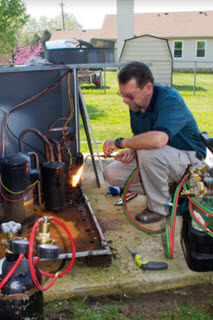 The effort to phase out these ozone-depleting materials has been going on ever since the early 1990s throughout the world. Some areas, such as Europe, have been ahead of the United States in the effort to phase out these ozone-depleting substances. The EPA has mandated a production limit of 18 million pounds of R-22 in the United States. This is a decrease from the 51 million pound limit in 2014. Production ceased entirely in 2020. This lack of production, while there is still a demand, is causing R-22 prices to rise.
The effort to phase out these ozone-depleting materials has been going on ever since the early 1990s throughout the world. Some areas, such as Europe, have been ahead of the United States in the effort to phase out these ozone-depleting substances. The EPA has mandated a production limit of 18 million pounds of R-22 in the United States. This is a decrease from the 51 million pound limit in 2014. Production ceased entirely in 2020. This lack of production, while there is still a demand, is causing R-22 prices to rise.
Still, R-22 is a common coolant even today. It is estimated by many HVAC contractors that about half of the units, that they service, still use the R-22 coolant. It is true that a unit containing R-22 has not been factory-shipped since around 2010. However, until recently, it was still common to buy an air conditioner unit without any coolant and fill it with R-22.
Refrigerant Leaks
For a unit that contains R-22, finding even the smallest of leaks is important. Prices continue to rise for the R-22 coolant since supplies are dwindling. Also, this is because it is longer manufactured. Prices for R-22 are expected to continue to rise. It will probably begin to rise even more sharply. A leak could also cause you issues in regards to violations of restrictions surrounding known refrigerant leaks. The EPA now has strict regulations in place that govern the timeliness of fixing known leaks. You could find yourself with a costly fine if you ignore a coolant leak in your air conditioner unit.
Supplies Of R-22
Since we reached the deadline of the final R-22 phase-out, supplies of R-22 are becoming more and more scarce. Once the price of this coolant gets too high, repairs are going to seem less economically appealing. Additionally, it is important to be on the lookout for service deals that seem “too good to be true.” In some cases, there have been contaminated or counterfeit coolants being used that have caused fires and explosions. Saving a few dollars by trying to extend the usage of your older air conditioner is definitely not worth risking the safety of your family and home.
If you do choose to have an older unit serviced, it is important to use a reputable service company. They need to have competent, certified technicians. Look for an EPA 608 certification when having your older R-22 air conditioner unit serviced. These are the only technicians legally allowed to handle the refrigerant. This certification proves that they have completed the required educational training. Also, they have passed the required certification exam. It is also important to note that once achieved, this certification does not expire. So, you should still make sure that the company and technicians you use are staying up on the latest regulations and methods.
Servicing Existing Units
What should you do if you have an older air conditioner unit that is either blowing warm air or has stopped working? Your first thought may be to call a service company. However, you might be surprised at how costly servicing one of these older units may be. This is due to the rising cost of the R-22 coolant that older air conditioners use. The cost of the R-22 is definitely going to factor into the overall cost of servicing the unit. When the fix requires a recharge of the refrigerant, the service is astronomical.
It is important to note that the rising cost of coolant has the potential to impact a wide variety of preventative and emergency service calls. After all, recharging the refrigerant is one of the staples of air conditioner repair and maintenance. The more expensive servicing an older unit becomes, the more attractive the option of replacing it with a newer unit seems.
The Importance Of Regular AC Maintenance
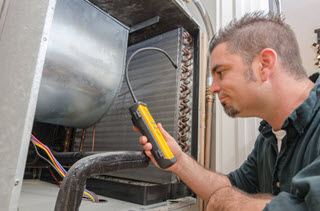 If a leak does not occur in your older air conditioner unit, there is a good chance that you may be able to get a few more years out of it before the R-22 ban starts to cause you problems. If you would normally be considering the purchase of a new air conditioner, as long as your older unit does not leak, you might be able to just wait it out and get a new unit even after the ban. Proper regular maintenance is one of the best ways to keep an older unit in good working condition. This extends its useful life until you can buy a newer unit that utilizes the newer coolants. Of course, it is also important to factor in the energy and cost-efficiency of a newer unit when thinking about the continued use of an old air conditioner.
If a leak does not occur in your older air conditioner unit, there is a good chance that you may be able to get a few more years out of it before the R-22 ban starts to cause you problems. If you would normally be considering the purchase of a new air conditioner, as long as your older unit does not leak, you might be able to just wait it out and get a new unit even after the ban. Proper regular maintenance is one of the best ways to keep an older unit in good working condition. This extends its useful life until you can buy a newer unit that utilizes the newer coolants. Of course, it is also important to factor in the energy and cost-efficiency of a newer unit when thinking about the continued use of an old air conditioner.
What about the option of getting an older air conditioner unit retrofitted with parts that will allow it to use a replacement coolant? If done correctly, retrofits can be made that will allow an air conditioner to switch coolants. However, this is work that should be done by an expert. However, it is not always the most cost-efficient way of dealing with the issue in the long run. Still, it might be something to consider when your older unit is still in good shape and you are not considering its replacement for a number of years.
Differences In Refrigerant Pressure
However, it is a much more complex matter than simply switching the R-22 coolant to R-410A. This could cause a dangerous situation. This is due to differences in working pressure. An expert, when performing a retrofit, will know which components need to be replaced so that the older unit can use a different coolant. Still, the EPA warns against using unapproved refrigerants in units. It is dangerous. There have been incidents of fires and explosions attributed to using the wrong coolant in an air conditioner unit. A reputable service company with qualified and certified technicians is the key to success.
So, what material is replacing the R-22 coolant? There are blended hydrofluorocarbons, such as R-410A, that are coming into use. Coolants such as this have not been found to deplete the ozone as the older coolants do. The new air conditioner units are being designed specifically to use the replacement coolants. These new systems are highly effective and very energy efficient. As such, you could find yourself paying lower utility bills after purchasing a new unit. In addition, you will feel more comfortable in your home. As an added bonus, there are tax credits and rebates that help make the switch to a new, energy-efficient air conditioning unit even more attractive.
If you are thinking about purchasing a new air conditioner, what should you be looking for? Look for the Energy Star label. This is a sign that you can save significantly on your energy bills. New units offer up to a 40 percent savings. Also, pay attention to the minimum seasonal energy efficiency (SEER) specification when buying a new unit. When you are considering the purchase of a new unit, the time to buy is before you start being negatively affected by the higher costs of servicing, maintaining and repairing your older unit that is still using the R-22 coolant.
Ozone-friendly Alternatives
Going Ductless
 There are plenty of good options to consider when you are ready to buy a new unit. Going ductless is one way to save. They add value and comfort to your home. Ductless systems are designed to take zones of your home into consideration. They direct air right to these various zones. This is different than traditional central air conditioning systems and heat pumps that uniformly force the cooled air through the ductwork of a home.
There are plenty of good options to consider when you are ready to buy a new unit. Going ductless is one way to save. They add value and comfort to your home. Ductless systems are designed to take zones of your home into consideration. They direct air right to these various zones. This is different than traditional central air conditioning systems and heat pumps that uniformly force the cooled air through the ductwork of a home.
Components Of A Ductless System
These ductless systems can be quite convenient. They consist of a small unit outdoors and then one or more indoor units. All that is required is electricity access and some mounting. Ductless systems are referred to by several different terms. This includes split systems, split-ductless, or multi-split systems.
These systems are a good alternative when adding on to a home. They are a great way to do away with space heaters, electric baseboard heaters, and window units. Replacing all these inefficient heating and cooling systems with a new ductless system can save money. It will make your home more uniformly comfortable. They are also a great way to improve the comfort in specific rooms of the home. They can help solve the problem of certain areas of the home being too cool or warm.
Ductless Systems Save Money
Ductless systems can save money in a variety of ways. They can work on less power as compared to a traditional forced-air system. It is a more efficient way to heat and cool a home. This is because it takes the various zones of a home into consideration. This prevents wasting energy heating or cooling rooms that are not being used. Instead, it comfortably cools or heats the areas that are being used. There are also tax credits and rebates that can make installing a ductless system even more attractive and economical.
Explore More On Ductless Systems
Indoor Air Quality
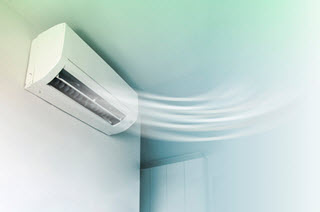 Ductless systems are also a great way to improve the overall quality of air within a home. It is unfortunately quite common for the quality of the air inside of a home to be lower than the quality of air outdoors. Traditional forced air systems are quite dependent upon regular professional cleanings in order to maintain good air quality. Even then, they still create indoor air issues. Allergens and dust can become a problem. In fact, some people who are sensitive to dust and allergens can even have problems with a forced air system after it has been professionally cleaned. Pollen, dust, bacteria, particulates, and other allergens can make a home an unhealthy place. With a ductless system, that offers multi-stage filtration, these irritants are more effectively removed from the air. This results in cleaner, healthier air that is better to breathe.
Ductless systems are also a great way to improve the overall quality of air within a home. It is unfortunately quite common for the quality of the air inside of a home to be lower than the quality of air outdoors. Traditional forced air systems are quite dependent upon regular professional cleanings in order to maintain good air quality. Even then, they still create indoor air issues. Allergens and dust can become a problem. In fact, some people who are sensitive to dust and allergens can even have problems with a forced air system after it has been professionally cleaned. Pollen, dust, bacteria, particulates, and other allergens can make a home an unhealthy place. With a ductless system, that offers multi-stage filtration, these irritants are more effectively removed from the air. This results in cleaner, healthier air that is better to breathe.
Installation
The quick and easy installation of ductless systems is yet another reason for their popularity. The installation of ductwork can really disrupt a home. It is a costly and time-intensive process. In the case of a ductless system, the work can often be done in a single day. The installation is far less complicated, messy, and invasive. The pipework that a multi-split system uses is small, requiring much smaller holes as compared to traditional ductwork. This means less destruction of walls, ceilings and floors, and less space being occupied by ducts.
Energy Efficient
 The energy efficiency of these systems also makes them attractive. If you wish to decrease the size of your home’s “carbon footprint”, a ductless system is a great option. These systems follow Energy Star guidelines and are quite energy efficient. In addition to saving money on your electric bills, you will have peace of mind that your energy usage has a minimal impact on the world around you. These new systems do not use the ozone-depleting R-22 coolant. These units are a great way to increase the comfort of your home, save money, and be kind to the environment.
The energy efficiency of these systems also makes them attractive. If you wish to decrease the size of your home’s “carbon footprint”, a ductless system is a great option. These systems follow Energy Star guidelines and are quite energy efficient. In addition to saving money on your electric bills, you will have peace of mind that your energy usage has a minimal impact on the world around you. These new systems do not use the ozone-depleting R-22 coolant. These units are a great way to increase the comfort of your home, save money, and be kind to the environment.
R-410A Coolant Air Conditioner Units
Even if a ductless system is not for you, buying a new air conditioner unit will move you from using the R-22 coolant to the more environmentally friendly R-410A coolant. A unit using R-410A coolant will actually result in a cooler-running compressor. This is due to the coolant’s ability to absorb and then release more heat. A cooler-running system will be less likely to overheat, and the compressor will be less likely to burn out.
These new systems are also designed to work at a higher pressure. This means that the new compressors are less likely to crack because they have been specially designed for higher pressures. You should never simply switch the coolant in an older unit. There is too much difference in pressure. If you were to put R-410A into an air conditioner designed for the R-22 coolant, it would not work. Breakage or even explosions occur. An R-410A system simply works more efficiently. This results in less wear and tear. It also translates into a long expected life for the unit.
Is It Time To Replace Your Air Conditioner?
Deciding What To Do
When you are concerned about the environment and wish to lessen your carbon footprint, switching from an R-22 air conditioner to a new R-410A system can give you peace of mind. When you think about all the homes within the United States that have AC units installed, the thought is staggering. Consider how many of those units are using the ozone-depleting R-22 coolant. Also, think about how many of those units may unknowingly have leaks. With this, it is easy to see what a danger this can be to the Earth’s environment.
Pros And Cons
Saving money is important to you. Therefore, it is important to weigh the pros and cons of switching to a new system now. Yes, you can potentially save some money by getting a few more years out of your existing R-22 AC unit. However, you may unknowingly be paying much higher energy costs. This is because of the unit’s inefficiency. Also, it is possible that it is not a good match for the current layout of your home. When you factor in the energy savings as well as the tax credits and rebates available when switching over to a more energy-efficient unit, you will feel surprised at how much money you could save.
If you do decide to stick with your R-22 AC for a few more years, be sure to pay attention to proper maintenance and servicing. This will help to extend the useful life of your unit. Also, it will reduce the chances of a coolant leak going undetected.
Contact us now at (908) 707-1776 to find out more!
R-22 FAQs
What Refrigerants Do Air Conditioners Use?
Today, it is still common to find air conditioners in homes that use the R-22 coolant. However, as time goes by, these units will be replaced and outnumbered by air conditioners that use the more environmentally friendly R-410A coolant. The new units are dependable, efficient, and help save on energy bills. As an added bonus, they also tend to be quieter while in operation. Yes, R-22 has been used for decades, and it has been a staple within the HVAC realm. However, it has served its purpose, and it is time for it to step down as the most common coolant. As R-410A units gradually replace the older R-22 units, the ozone in our Earth’s environment will definitely benefit.
What Are HCFC Refrigerants?
Hydrochlorofluorocarbons, commonly referred to as HCFCs, are chemicals commonly used as refrigerants. These chemicals, unfortunately, contribute to climate change and cause depletion of the Earth’s ozone layer. R-22 is one of these HCRC refrigerants commonly used for air conditioning. It is being phased out to help protect the environment.
Is R-22 Already Illegal?
It is important to understand that R-22 is not illegal to use in all situations – yet. This refrigerant can still be used to service existing units. It will continue to be legal to use even after the completion of the phase-out. Still, the continued usage of R-22, especially since we have past the final phase-out date of January 1, 2020, will continue to make the price of this substance rise. This will happen until it can eventually no longer be used at all.
How Much Does A Pound Of R-22 Cost?
Back in 2015, a thirty-pound cylinder of R-22 retailed for about $300. By 2016, the same thirty-pound cylinder retailed for about $480. In 2017, the price for a thirty-pound cylinder is between $600 and $700. The price has been steadily climbing and will continue to climb. The projected price for a thirty-pound cylinder of R-22 in 2018 is set at $928.
What Is R-22 Refrigerant?
R-22, also known as HCFC-22, is a colorless gas. Chlorodifluoromethane, or difluoro monochloromethane, is a hydrochlorofluorocarbon (HCFC). It has been commonly used as a refrigerant and as a propellant. The United States and other developed countries have phased out the R-22 coolant. However, developing countries still have a demand for it. Ultimately, the environment benefits when the usage of this ozone-depleting coolant is phased out altogether.
Which Gas Is Used In Air Conditioners?
Taking coolant into consideration is important because it is what makes air conditioners possible. Without the cooling and dehumidifying properties made possible by the coolant within the coils of an air conditioner, there would be no cooling at all. R-22 is the most common gas used within air conditioning systems. It has been for quite a long time. Since the R-22 phase-out is complete, more environmentally friendly alternatives are being used. R-410A is a chlorine-free alternative that the EPA recognizes as a good alternative. The absence of chlorine makes it more ozone-friendly.
High-efficiency cooling systems are using R-410A refrigerants. These systems are, therefore, economically beneficial as well as being better for the environment. These systems tend to operate more quietly and provide improved reliability, dehumidification, and overall performance. Its operating pressures are also higher than R-22. This means systems that use this refrigerant are designed to work at higher pressures.
Can The Condensing Unit (The Outside Unit) On A Home Air Conditioner Containing HCFC-22 Be Replaced?
Replacing the outdoor unit, which contains the compressor, is an alternative for an existing R-22 system. This can be a good way to get an air conditioner operating again. This saves time, effort, and money involved in changing the indoor system components. If the indoor components, including the blower and cooling coil, are still in good condition, and you can find the R-22 coolant and outdoor replacement parts, this approach could save you money.
This type of repair will remain feasible as long as replacement parts continue to be available. Also, some R-22 indoor coils that were built since 2016 are specifically designed so that they would be R-410A compatible. This makes upgrading to a new outdoor unit while retaining the indoor components a viable option. Of course, it will not improve the overall efficiency of the system since it is a replacement of only the outdoor components. Some of these replacement options may save some money short-term and buy some time. However, they are not long-term solutions for the R-22 phase-out.
Do I Need To Stop Using HCFC-22 In My Home’s Air Conditioner?
The United States has phased out R-22. This means that the production and importation of this common refrigerant is no longer occurring. This is due to its detrimental effects on the ozone layer. R-22 is no longer be produced or imported as of 2020. As a result of the phase-out and a continually dwindling supply of R-22, the price is rising. It will continue to rise.
If your air conditioner currently uses R-22, repairs and maintenance are going to become more expensive. If your air conditioner leaks, recharging the system with R-22 is going to be expensive. As the phase-out has been completed, recharging a system with R-22 is likely to become cost-prohibitive, or perhaps even impossible. HVAC contractors can only receive a ration of R-22 coolant by manufacturers. This adds to the short supply and rising costs.

